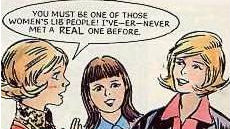The “War on Women:” A Two-Front Conflict

In November of 1977, Houston hosted a national women’s conference to hammer out a broad agenda against sexual inequality. It was hailed as the most diverse American political gathering in memory—aside from the absence of men.*
At this time, feminism was popular, even mainstream. A majority of women, well over three-fourths, by most polls, expressed sympathy with it.
Sam Houston Arena felt like a political bazaar. The conference “was like a supermarket checkout line from Anywhere USA… Homemakers and nuns, teenagers and senior citizens, secretaries and farmers and lawyers,” “pro-feminist churchwomen” and NOW representatives congenially rubbed elbows. The Nation saw great promise for feminism as a unifying liberal worldview. “The women’s movement has become a bridge between groups that represent very different social interests,” it reported.
The conference had an ambitious platform to approve, from inheritance tax to sexual violence to job discrimination. In the first day, conference leaders moved alphabetically, and easily, through consensus issues.
A tougher debate loomed with the “R” word—reproductive freedom, and abortion.
Abortion was the most emotional issue at the conference, and the atmosphere grew uncharacteristically tense and fractious when it came up. Abortion didn’t enjoy the moral legibility of other agenda items.
Before the vote, Joan Gubbins, a leader of the hastily-named “antis,” led a group of women in a chorus of “All We Are Saying is Give Life a Chance,” while Gloria Steinem tentatively countered with a chant of what must have then felt like a clever turn of phrase– “choice, choice, choice, choice.”
The “pro-choice” factions won this skirmish in a newly-engaged war. The abortion platform passed—but not without a cost.
Shaking and weeping, one anti-abortion delegate told a reporter, “I never thought they would come to this. It’s murder.” Said another, “it will be old people next.” Delegates from the business community interested in economic issues were perplexed, too, that “the emotional issues had predominated.”
Reporter Anne Taylor Fleming came away from Houston reassured that feminism was still a unifying idea (although abortion had been revealed not to be one), and vaguely troubled by gathering political winds. She prophesied, “One felt absolutely in the mainstream…knowing all the while that there was another mainstream out there…and that the two were destined to clash again.”
Fleming called it a gathering “civil war of women.”
Women’s opposition to abortion shows up less anecdotally in The General Social Surveys (GSS), Gallup, Harris, and other national surveys from the 1970s. These surveys revealed women to be more “pro-life” than men.
A 1974 Gallup survey found that 51% of men and 43% of women favored the “pro-choice” position. Robert Shapiro concludes in a secondary analysis of opinion surveys that women were consistently more “traditional” in their values toward abortion, and men “consistently more pro-choice” in the 1970s. Researcher Catherine Bolzendahl finds in an analysis of GSS data from the 1970s through the 1980s that men’s and women’s opinions on abortion differ only slightly. “Men always supported abortion more than women,” she finds, although the gap wasn’t statistically significant.
Women also founded and led several anti-abortion organizations that predate or are concurrent with Jerry Falwell’s Moral Majority (1979). They include the anti-abortion rights group Life Advocates (1977), the American Life Lobby (1979), and the “pro-family alliance” (1979). Typical of the grassroots activity, Cheri Bowman, a 30-year old “smiling, blond mother of two” whose father-in-law invented bubble gum, delivered an anti-abortion lecture and slide show in 1975 to the ladies auxiliary of a Roman Catholic Church in Georgia. Newsweek reported on the strange new phenomenon, describing Cheri’s “logical and low-keyed slide show” that nevertheless “left no emotional nerve untouched.”
In 1976 Ellen McCormack, a suburban New York housewife and mother of four, competed for the Democratic presidential nomination as a single-issue, pro-life candidate, and qualified for Federal matching funds for her campaign.
It’s unwise, or at least arbitrary, to assume that these women were deluded; alibis for their husbands and male church leaders; or victims of false consciousness.
The most elegant interpretation is that women in the 1970s who identified as feminists had divided views on abortion, and for doubtlessly complex reasons.
To complicate things, abortion politics was often a proxy for growing class and lifestyle divisions among women. In 1976, the conservative National Review wisely described abortion as a coded expression of “class warfare”—eventually to be re-coded as cultural warfare.
Jane Broderick, for example, was a mother of eight, a “deeply religious” Catholic, and an abortion foe. She identified herself as a feminist in 1977, but confessed that she felt “alienated from the movement at times,” because of abortion and, relatedly, because she sensed class condescension toward women such as herself who lived “small, trite, little lives” in American towns, she told Ms. magazine.
Ann Giordano, a married clerical worker, also worried about feminism’s drift toward the preoccupations of the career woman and what she perceived to be a disdain for “hard hats.” But in 1976, she was opting to fight under the feminist banner and not against it. “People like [me] should get involved” in the women’s movement. “If we just sit back and say, the hell with you, we’ll never make [feminists] relate to our needs.”
Much of this unfolded, at least early on, as a conflict among women.
Newsweek reported in 1976 that women’s organizations themselves were taking a cautious approach to abortion, perhaps in recognition of the intense feelings about it. They had yet to “jump into the fray” energetically, although reproductive rights had always been part of the feminist agenda.
Once these organizations did jump into the fray, in the 1980s, abortion would become a foundation of feminist fundraising and advocacy.
On the one hand, the issue does mobilize donations, and galvanize support among one group of women. On the other hand, it was perhaps the most polarizing issue—between women themselves, and among self-identified feminists—from the start. And in this sense the abortion issue was a foundation built on a faultline.
* This is adapted from an essay I published in 2006 in the Michigan Quarterly Review, “Whiplash: A Secret History of Women’s Politics.” It seems relevant to the political scene today.





